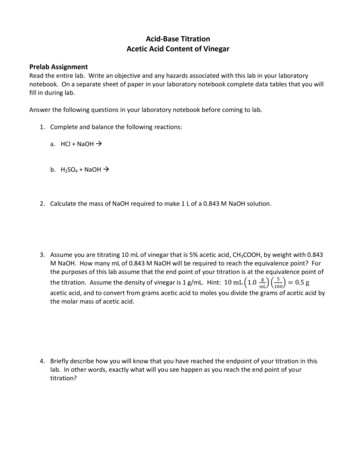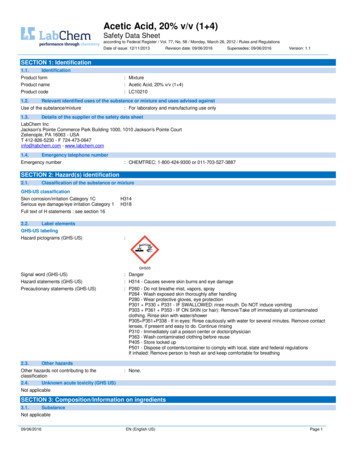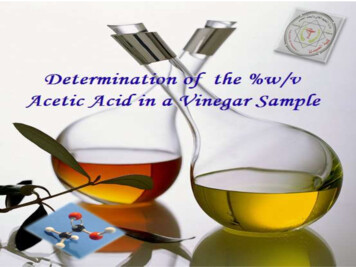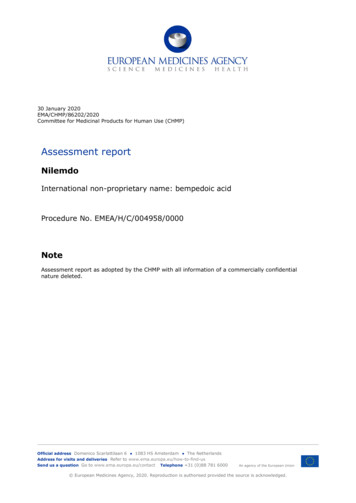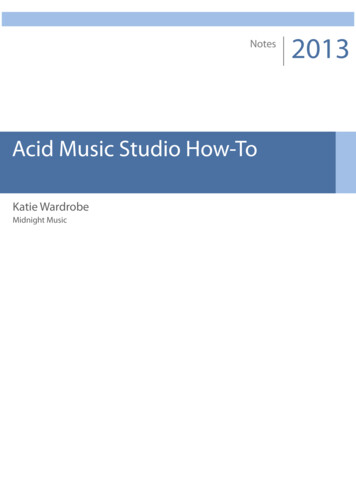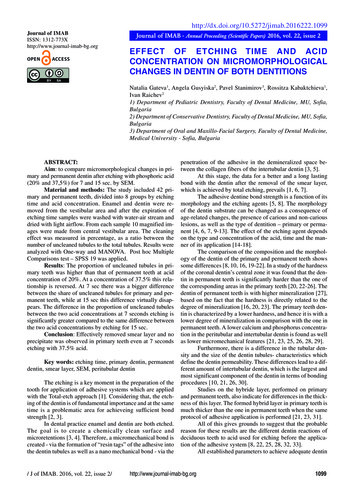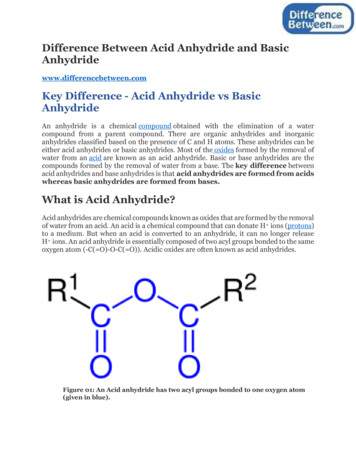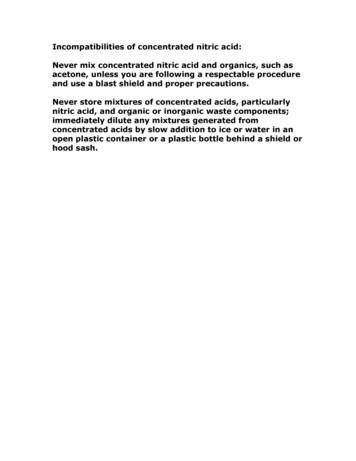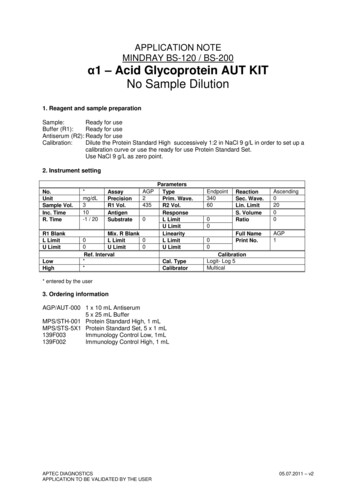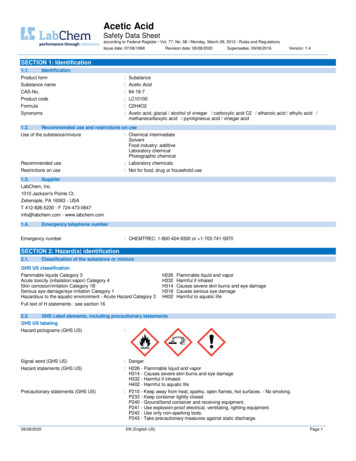
Transcription
Acetic AcidSafety Data Sheetaccording to Federal Register / Vol. 77, No. 58 / Monday, March 26, 2012 / Rules and RegulationsIssue date: 07/06/1998Revision date: 09/28/2020Supersedes: 09/06/2016Version: 1.4SECTION 1: Identification1.1.IdentificationProduct form: SubstanceSubstance name: Acetic AcidCAS-No.: 64-19-7Product code: LC10100Formula: C2H4O2Synonyms: Acetic acid, glacial / alcohol of vinegar / carboxylic acid C2 / ethanoic acid / ethylic acid /methanecarboxylic acid / pyroligneous acid / vinegar acid1.2.Recommended use and restrictions on useUse of the substance/mixture: Chemical intermediateSolventFood industry: additiveLaboratory chemicalPhotographic chemicalRecommended use: Laboratory chemicalsRestrictions on use: Not for food, drug or household use1.3.SupplierLabChem, Inc.1010 Jackson's Pointe Ct.Zelienople, PA 16063 - USAT 412-826-5230 - F 724-473-0647info@labchem.com - www.labchem.com1.4.Emergency telephone numberEmergency number: CHEMTREC: 1-800-424-9300 or 1-703-741-5970SECTION 2: Hazard(s) identification2.1.Classification of the substance or mixtureGHS US classificationFlammable liquids Category 3Acute toxicity (inhalation:vapor) Category 4Skin corrosion/irritation Category 1BSerious eye damage/eye irritation Category 1Hazardous to the aquatic environment - Acute Hazard Category 3H226H332H314H318H402Flammable liquid and vaporHarmful if inhaledCauses severe skin burns and eye damageCauses serious eye damageHarmful to aquatic lifeFull text of H statements : see section 162.2.GHS Label elements, including precautionary statementsGHS US labelingHazard pictograms (GHS US):Signal word (GHS US): DangerHazard statements (GHS US): H226 - Flammable liquid and vaporH314 - Causes severe skin burns and eye damageH332 - Harmful if inhaledH402 - Harmful to aquatic lifePrecautionary statements (GHS US): P210 - Keep away from heat, sparks, open flames, hot surfaces. - No smoking.P233 - Keep container tightly closed.P240 - Ground/bond container and receiving equipment.P241 - Use explosion-proof electrical, ventilating, lighting equipment.P242 - Use only non-sparking tools.P243 - Take precautionary measures against static discharge.09/28/2020EN (English US)Page 1
Acetic AcidSafety Data Sheetaccording to Federal Register / Vol. 77, No. 58 / Monday, March 26, 2012 / Rules and RegulationsP260 - Do not breathe mist, vapors, spray.P264 - Wash exposed skin thoroughly after handling.P271 - Use only outdoors or in a well-ventilated area.P273 - Avoid release to the environment.P280 - Wear protective clothing, protective gloves, eye protection, face protection.P301 P330 P331 - IF SWALLOWED: Rinse mouth. Do NOT induce vomiting.P303 P361 P353 - IF ON SKIN (or hair): Remove/Take off immediately all contaminatedclothing. Rinse skin with water/shower.P304 P340 - IF INHALED: Remove person to fresh air and keep comfortable for breathing.P305 P351 P338 - IF IN EYES: Rinse cautiously with water for several minutes. Removecontact lenses, if present and easy to do. Continue rinsing.P310 - Immediately call a poison center or doctor/physician.P363 - Wash contaminated clothing before reuse.P370 P378 - In case of fire: Use carbon dioxide (CO2), powder, alcohol-resistant foam toextinguishP403 P235 - Store in a well-ventilated place. Keep cool.P405 - Store locked up.P501 - Dispose of contents/container to comply with local, state and federal regulations.2.3.Other hazards which do not result in classificationOther hazards not contributing to theclassification2.4.: None.Unknown acute toxicity (GHS US)Not applicableSECTION 3: Composition/Information on ingredients3.1.SubstancesSubstance type: Mono-constituentNameProduct identifier%GHS US classificationAcetic Acid(CAS-No.) 64-19-7100Flam. Liq. 3, H226Acute Tox. 4(Inhalation:vapour), H332Skin Corr. 1B, H314Eye Dam. 1, H318Aquatic Acute 3, H402(Main constituent)Full text of hazard classes and H-statements : see section 163.2.MixturesNot applicableSECTION 4: First-aid measures4.1.Description of first aid measuresFirst-aid measures general: Check the vital functions. Unconscious: maintain adequate airway and respiration. Respiratoryarrest: artificial respiration or oxygen. Cardiac arrest: perform resuscitation. Victim consciouswith labored breathing: half-seated. Victim in shock: on his back with legs slightly raised.Vomiting: prevent asphyxia/aspiration pneumonia. Prevent cooling by covering the victim (nowarming up). Keep watching the victim. Give psychological aid. Keep the victim calm, avoidphysical strain. Depending on the victim's condition: doctor/hospital.First-aid measures after inhalation: Remove the victim into fresh air. Immediately consult a doctor/medical service. Doctor:administration of corticoid spray.First-aid measures after skin contact: Wash immediately with lots of water (15 minutes)/shower. Do not apply (chemical) neutralizingagents without medical advice. Remove clothing while washing. Do not remove clothing if itsticks to the skin. Cover wounds with sterile bandage. Consult a doctor/medical service. Ifburned surface 10%: take victim to hospital.First-aid measures after eye contact: Rinse immediately with plenty of water for 15 minutes. Remove contact lenses, if present andeasy to do. Continue rinsing. Do not apply (chemical) neutralizing agents without medicaladvice. Take victim to an ophthalmologist.First-aid measures after ingestion: Rinse mouth with water. Immediately after ingestion: give lots of water to drink. Do not inducevomiting. Do not apply (chemical) neutralizing agents without medical advice. Immediatelyconsult a doctor/medical service. Call Poison Information Centre (www.big.be/antigif.htm).Ingestion of large quantities: immediately to hospital. Take the container/vomit to thedoctor/hospital.4.2.Most important symptoms and effects (acute and delayed)Potential Adverse human health effects andsymptoms09/28/2020: Practically non-toxic if swallowed (LD50 oral, rat 2000 mg/kg). Causes severe skin burns.Causes serious eye damage.EN (English US)2/10
Acetic AcidSafety Data Sheetaccording to Federal Register / Vol. 77, No. 58 / Monday, March 26, 2012 / Rules and RegulationsSymptoms/effects after inhalation: Coughing. Dry/sore throat. Respiratory difficulties. Corrosion of the upper respiratory tract.FOLLOWING SYMPTOMS MAY APPEAR LATER: Risk of pneumonia. Risk of lung edema.Symptoms/effects after skin contact: Caustic burns/corrosion of the skin.Symptoms/effects after eye contact: Corrosion of the eye tissue.Symptoms/effects after ingestion: Burns to the gastric/intestinal mucosa. Possible esophageal perforation. Blood in vomit.Diarrhoea. Shock. Low arterial pressure. Enlargement/disease of the liver. Decreased renalfunction.Chronic symptoms: Affection/discolouration of the teeth.4.3.Immediate medical attention and special treatment, if necessaryObtain medical assistance.SECTION 5: Fire-fighting measures5.1.Suitable (and unsuitable) extinguishing mediaSuitable extinguishing media: Quick-acting ABC powder extinguisher. Quick-acting BC powder extinguisher. Quick-actingclass B foam extinguisher. Quick-acting CO2 extinguisher. Class B foam (alcohol-resistant).Water spray if puddle cannot expand.Unsuitable extinguishing media: Water (quick-acting extinguisher, reel); risk of puddle expansion. Water; risk of puddleexpansion.5.2.Specific hazards arising from the chemicalFire hazard: DIRECT FIRE HAZARD. Flammable liquid and vapour. Gas/vapor flammable with air withinexplosion limits. INDIRECT FIRE HAZARD. May be ignited by sparks. Reactions involving afire hazard: see "Reactivity Hazard".Explosion hazard: DIRECT EXPLOSION HAZARD. Gas/vapour explosive with air within explosion limits.INDIRECT EXPLOSION HAZARD. may be ignited by sparks. Reactions with explosionhazards: see "Reactivity Hazard".Hazardous decomposition products in case offire: Upon combustion: CO and CO2 are formed.5.3.Special protective equipment and precautions for fire-fightersFirefighting instructions: Cool tanks/drums with water spray/remove them into safety. Do not move the load if exposed toheat. Take account of toxic fire-fighting water. Use water moderately and if possible collect orcontain it.Protection during firefighting: Do not enter fire area without proper protective equipment, including respiratory protection.SECTION 6: Accidental release measures6.1.Personal precautions, protective equipment and emergency proceduresGeneral measures6.1.1.: Clean up any spills as soon as possible, using an absorbent material to collect it.For non-emergency personnelProtective equipment: Gas-tight suit (EN 943). Corrosion-proof suit (EN 14605).Emergency procedures: Keep upwind. Mark the danger area. Consider evacuation. Seal off low-lying areas. Closedoors and windows of adjacent premises. Stop engines and no smoking. No naked flames orsparks. Spark- and explosion-proof appliances and lighting equipment. Corrosion-proofappliances. Keep containers closed. Wash contaminated clothes.6.1.2.For emergency respondersProtective equipment: Equip cleanup crew with proper protection.Emergency procedures: Stop leak if safe to do so. Ventilate area.6.2.Environmental precautionsPrevent soil and water pollution. Prevent spreading in sewers.6.3.Methods and material for containment and cleaning upFor containment: Contain released substance, pump into suitable containers. Plug the leak, cut off the supply.Dam up the liquid spill. Try to reduce evaporation. Measure the concentration of the explosivegas-air mixture. Dilute combustible/toxic gases/vapours with water spray. Take account oftoxic/corrosive precipitation water. Provide equipment/receptacles with earthing. Do not usecompressed air for pumping over spills.Methods for cleaning up: Take up liquid spill into inert absorbent material, e.g.: sand, earth, vermiculite or kieselguhr,powdered limestone. Scoop absorbed substance into closing containers. Carefully collect thespill/leftovers. Damaged/cooled tanks must be emptied. Do not use compressed air forpumping over spills. Clean contaminated surfaces with an excess of water. Take collected spillto manufacturer/competent authority. Wash clothing and equipment after handling.09/28/2020EN (English US)3/10
Acetic AcidSafety Data Sheetaccording to Federal Register / Vol. 77, No. 58 / Monday, March 26, 2012 / Rules and Regulations6.4.Reference to other sectionsNo additional information availableSECTION 7: Handling and storage7.1.Precautions for safe handlingAdditional hazards when processed: Flammable vapors may accumulate in the container.Precautions for safe handling: Use spark-/explosionproof appliances and lighting system. Take precautions againstelectrostatic charges. Keep away from naked flames/heat. Keep away from ignitionsources/sparks. Measure the concentration in the air regularly. Work under localexhaust/ventilation. Exhaust gas must be neutralised. Comply with the legal requirements.Remove contaminated clothing immediately. Clean contaminated clothing. Keep the substancefree from contamination. Use corrosionproof equipment. Handle uncleaned empty containersas full ones. Thoroughly clean/dry the installation before use. Do not discharge the waste intothe drain. Do not use compressed air for pumping over. Keep container tightly closed.Hygiene measures: Do not eat, drink or smoke when using this product. Wash contaminated clothing before reuse.Wash hands and other exposed areas with mild soap and water before eating, drinking orsmoking and when leaving work.7.2.Conditions for safe storage, including any incompatibilitiesIncompatible products: Strong bases. Oxidizing agent. metals.Incompatible materials: Direct sunlight. Heat sources. Sources of ignition.Storage temperature: 17 CHeat-ignition: KEEP SUBSTANCE AWAY FROM: heat sources. ignition sources.Prohibitions on mixed storage: KEEP SUBSTANCE AWAY FROM: combustible materials. oxidizing agents. (strong) bases.metals. alcohols. amines. water/moisture.Storage area: Store in a dry area. Keep container in a well-ventilated place. Keep out of direct sunlight.Fireproof storeroom. Keep locked up. Provide for a tub to collect spills. Provide the tank withearthing. Detached building. Store only in a limited quantity. Meet the legal requirements.Special rules on packaging: SPECIAL REQUIREMENTS: closing. dry. clean. correctly labelled. meet the legalrequirements. Secure fragile packagings in solid containers.Packaging materials: SUITABLE MATERIAL: stainless steel. aluminium. LDPE (Low Density Poly Ethylene). HDPE.glass. MATERIAL TO AVOID: iron. zinc. lead. copper. bronze. natural rubber.SECTION 8: Exposure controls/personal protection8.1.Control parametersAcetic Acid (64-19-7)USA - ACGIH - Occupational Exposure LimitsLocal nameACGIH TWA (mg/m³)ACGIH TWA (ppm)ACGIH STEL (mg/m³)ACGIH STEL (ppm)Remark (ACGIH)Regulatory referenceUSA - OSHA - Occupational Exposure LimitsAcetic acid25 mg/m³10 ppm37 mg/m³15 ppmTLV Basis: URT & eye irr; pulm funcACGIH 2020Local nameOSHA PEL (TWA) (mg/m³)OSHA PEL (TWA) (ppm)Regulatory reference (US-OSHA)USA - IDLH - Occupational Exposure LimitsAcetic acid25 mg/m³10 ppmOSHA Annotated Table Z-1US IDLH (ppm)USA - NIOSH - Occupational Exposure Limits50 ppmNIOSH REL (TWA) (mg/m³)NIOSH REL (TWA) [ppm]NIOSH REL (STEL) (mg/m³)NIOSH REL (STEL) [ppm]25 mg/m³10 ppm37 mg/m³15 ppm09/28/2020EN (English US)4/10
Acetic AcidSafety Data Sheetaccording to Federal Register / Vol. 77, No. 58 / Monday, March 26, 2012 / Rules and Regulations8.2.Appropriate engineering controlsAppropriate engineering controls8.3.: Emergency eye wash fountains and safety showers should be available in the immediatevicinity of any potential exposure. Material should be handled in a laboratory hood wheneverpossible.Individual protection measures/Personal protective equipmentPersonal protective equipment:Protective goggles. Gloves. Face shield. Gas mask with filter type E. Chemical resistant apron.Materials for protective clothing:GIVE LESS RESISTANCE: natural rubber. GIVE POOR RESISTANCE: polyethylene.
Substance name : Acetic Acid CAS-No. : 64-19-7 Product code : LC10100 Formula : C2H4O2 Synonyms : Acetic acid, glacial / alcohol of vinegar / carboxylic acid C2 / ethanoic acid / ethylic acid / methanecarboxylic acid / pyroligneous acid / vinegar acid . 1.2. File Size: 292KBPage Count: 9
